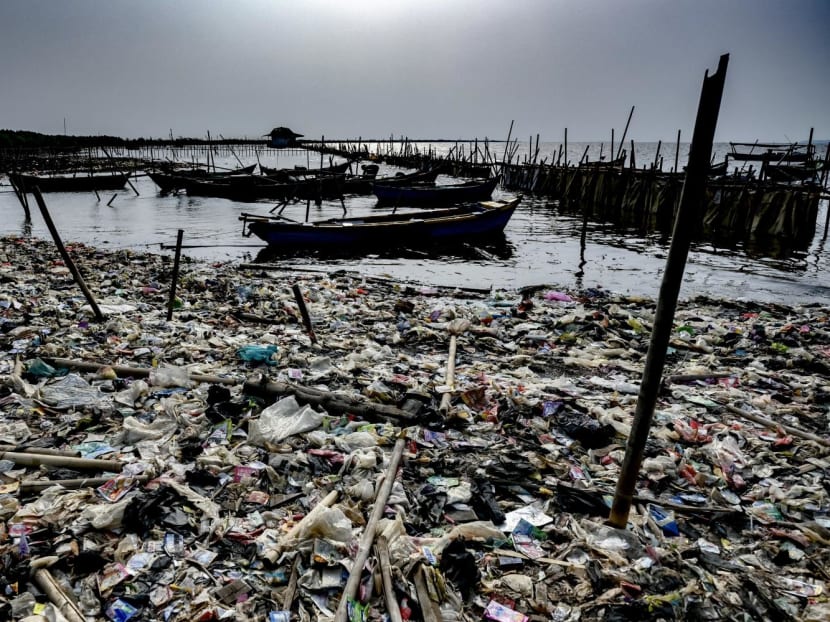Less plastic flowing into ocean than thought, but more found floating in waters: Study
SINGAPORE — A new study has found that the amount of plastic entering the oceans is lower than previously estimated by scientists, but the volume floating on the water surface is much higher than earlier estimates.

A fisherman preparing his boat for fishing next to a dirty beach filled with plastic waste at Tanjung Pasir beach in Tangerang, Indonesia on July 28, 2023.
- The amount of plastic litter entering the ocean is lower than previously thought, a study found
- However, the total amount of buoyant plastic litter on ocean surfaces is much higher than earlier estimates
- The study's findings were published in scientific journal Nature Geoscience on Aug 7
- What this means is that the lifetime of plastics in the marine environment is even higher than previously thought
- The researchers also believe that plastic pollution in the ocean is “probably still growing around 4 per cent per year”
SINGAPORE — A new study has found that the amount of plastic entering the ocean is lower than previously estimated by scientists, but the volume floating on the water surface is much higher than earlier estimates.
This also means that the lifetime of plastics in marine environments is even higher than previously thought, the study’s authors from Utrecht University in the Netherlands said.
Their findings were published in scientific journal Nature Geoscience on Monday (Aug 7).
TODAY takes a closer look at the numbers, what they mean and what should be done moving forward to manage plastic pollution in the oceans.
HOW MUCH PLASTIC WASTE ENTERS THE OCEANS?
To conduct the study, the researchers used a combination of mathematical models and simulations to evaluate different scenarios in different months.
This includes setting parameters to consider plastic pollution sources from rivers, coastlines and fishing activity, and looking at how plastics go through biological processes differently, for example, in different months.
Around 3 billion kg to 3.4 billion kg of buoyant plastic waste float on the ocean's surface, the study found.
This amount is much higher than earlier estimates of around 250 million kg cited by various studies, which could have overestimated how much plastic was removed from the ocean surface through biological processes.
These processes include biofouling, or the build-up of aquatic organisms on ships’ hulls or submerged structures such as platforms and aquaculture installations.
The latest study also found that around 470 to 540 million kg of plastic litter continue to enter the marine environment yearly.
Although this is significantly lower than previous estimates of plastic pollution entering from rivers and coastlines that range from 5.6 billion kg to 25.4 billion kg in various studies, the researchers also found that the majority of plastic litter in the ocean “originates from the ocean”. This included items such as nets, ropes and buoys.
The researchers also believe that the growth rate of plastic pollution in the ocean is “probably still growing around 4 per cent per year”.
Furthermore, these figures only account for plastic waste on the ocean’s surface.
The study focused on measuring the amount of plastics that were “initially buoyant when entering the marine environment” and “do(es) not consider polymers denser than seawater”.
While the largest fraction (59 to 62 per cent) of plastic mass is located at the ocean’s surface, more than a third (36 to 39 per cent) of marine plastic pollution resides deeper in the ocean, the study stated.
WHY IT MATTERS
The high amount of plastic waste found on the ocean’s surface, in spite of the lower-than-expected input of plastic into the ocean, suggested that plastic litter would likely remain in the ocean for much longer than previously believed.
The study’s leader Mikael Kaandorp said: “It means that it will take longer until the effects of measures to combat plastic waste will be visible."
Mr Kaandorp, who was a doctoral researcher at Utrecht University at the time of the study, added: “If we don't take action now, the effects will be felt for much longer.”
Without further mitigation and clean-up efforts, the estimated 4 per cent growth rate of plastic waste entering the marine environment could lead to the ocean’s plastic litter doubling within two decades, the researchers said.
In October 2021, the United Nations Environment Programme (UNEP) published a report, which found that plastics — as the “largest, most harmful and most persistent fraction of marine litter” — accounted for at least 85 per cent of total marine waste.
With plastic litter, all marine life face “the grave risk of toxification, behavioural disorder, starvation and suffocation,” UNEP said.
It added that corals, mangroves and seagrass beds are also “smothered by plastic waste”, as the litter prevents them from receiving oxygen and light.
WHAT ARE THE IMPLICATIONS?
Around 220 million kg of plastics are “exported” to marine sediments yearly through such biological processes, including biofouling, the researchers estimated.
This means that the plastic waste is merely removed from the ocean surface, but not necessarily the ocean.
Through sinking and degradation, the plastic pollutants may continue to accumulate on the seafloor, forming part of its sediment.
The study found that microplastics (typically smaller than 5mm) make up only eight per cent of the total plastic mass at the ocean's surface, while most of the plastic mass for particles smaller than 0.8mm is found below the ocean’s surface.
This also presents a cause for concern since “large, floating pieces on the surface are easier to clean up than microplastics”, the study’s co-author, Dr Erik van Sebille of Utrecht University in the Netherlands, said in a statement.
WHAT NEXT?
This “removal rate” of plastic particles from the ocean's surface — through processes such as biofouling and sedimentation — is also expected to “decrease rapidly” over time, as plastics move from coastal regions to the subtropical gyres, the researchers said.
An ocean gyre is a large system of circular ocean currents formed by global wind patterns and forces created by Earth’s rotation, National Geographic stated in an article on its website.
There are three major types of ocean gyres: Tropical, subtropical and subpolar.
Subtropical gyres, which make up most of the world’s major gyres, form between the polar and equatorial regions of the planet.
As ocean gyres circle large areas of stationary and calm water, debris that drift into these areas can accumulate for years due to the region’s lack of movement.
The circular motion of the gyre draws in the debris, mostly small particles of plastic. Eventually, the debris makes its way to the centre of the gyre, where it becomes trapped and breaks down into a kind of plastic soup, National Geographic reported.
The study's researchers said: “As there is no beaching and little sinking of marine plastics in these low algal areas compared with coastal waters, the plastic particles become highly persistent."
Highlighting the need for action to be taken, the researchers added: “Long-lived plastic pollution in the world’s oceans, which our model suggests is continuing to increase, could negatively impact ecosystems without countermeasures and prevention strategies.”
The study comes as the UNEP prepares to convene again in November this year, for its third discussion on an international treaty to combat plastic pollution, including in the marine environment.











